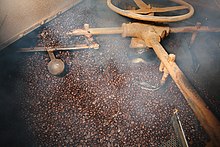
Five-spice powder is a spice mixture of five or more spices used predominantly in almost all branches of Chinese cuisine. It is also used in Hawaiian cuisine and Vietnamese cuisine. The five flavors of the spices refers to the five traditional Chinese elements.

Roasting is a cooking method that uses dry heat where hot air covers the food, cooking it evenly on all sides with temperatures of at least 150 °C (300 °F) from an open flame, oven, or other heat source. Roasting can enhance the flavor through caramelization and Maillard browning on the surface of the food. Roasting uses indirect, diffused heat, and is suitable for slower cooking of meat in a larger, whole piece. Meats and most root and bulb vegetables can be roasted. Any piece of meat, especially red meat, that has been cooked in this fashion is called a roast. Meats and vegetables prepared in this way are described as "roasted", e.g., roasted chicken or roasted squash.
Malaysian cuisine consists of cooking traditions and practices found in Malaysia, and reflects the multi-ethnic makeup of its population. The vast majority of Malaysia's population can roughly be divided among three major ethnic groups: Malays, Chinese and Indians. The remainder consists of the indigenous peoples of Sabah and Sarawak in East Malaysia, the Orang Asli of Peninsular Malaysia, the Peranakan and Eurasian creole communities, as well as a significant number of foreign workers and expatriates.

Punjabi cuisine is a culinary style originating in the Punjab, a region in the northern part of South Asia, which is now divided in an Indian part to the east and a Pakistani part to the west. This cuisine has a rich tradition of many distinct and local ways of cooking. One is a special form of tandoori cooking that is now famous in other parts of Pakistan and India, England, Canada, America, and in many other parts of the world.

Arab cuisine is the cuisine of the Arabs, defined as the various regional cuisines spanning the Arab world, from the Maghreb to the Fertile Crescent and the Arabian Peninsula. These cuisines are centuries old and reflect the culture of trading in baharat (spices), herbs, and foods. The regions have many similarities, but also unique traditions. They have also been influenced by climate, cultivation, and mutual commerce.

Roasting coffee transforms the chemical and physical properties of green coffee beans into roasted coffee products. The roasting process is what produces the characteristic flavor of coffee by causing the green coffee beans to change in taste. Unroasted beans contain similar if not higher levels of acids, protein, sugars, and caffeine as those that have been roasted, but lack the taste of roasted coffee beans due to the Maillard and other chemical reactions that occur during roasting.

Czech cuisine has both influenced and been influenced by the cuisines of surrounding countries and nations. Many of the cakes and pastries that are popular in Central Europe originated within the Czech lands. Contemporary Czech cuisine is more meat-based than in previous periods; the current abundance of farmable meat has enriched its presence in regional cuisine. Traditionally, meat has been reserved for once-weekly consumption, typically on weekends.

Ugandan cuisine consists of traditional and modern cooking styles, practices, foods and dishes in Uganda, with English, Arab, and Asian influences.

Maharashtrian or Marathicuisine is the cuisine of the Marathi people from the Indian state of Maharashtra. It has distinctive attributes, while sharing much with other Indian cuisines. Traditionally, Maharashtrians have considered their food to be more austere than others.

The following outline is provided as an overview of and topical guide to food preparation:

Ghanaian cuisine is the cuisine of the Ghanaian people. Ghanaian main dishes are organized around a starchy staple food, which goes with a sauce or soup containing a protein source. The main ingredients for the vast majority of soups and stews are tomatoes, hot peppers and onions. As a result, most of the Ghanaian soups and stews are red or orange in appearance.

Spice rub is any mixture of ground spices that is made to be rubbed on raw food before the food is cooked. The spice rub forms a coating on the food. The food can be marinated in the spice rub for some time for the flavors to incorporate into the food, or it can be cooked immediately after it is coated in the rub. The spice rub can be left on or partially removed before cooking.

Madras curry or Madras sauce is a fairly hot curry sauce, orange in colour and with heavy use of chili powder. Raita is often used as an accompaniment to the dish.

Bhojpuri cuisine is a style of food preparation common among the Bhojpuri people of Bihar and eastern Uttar Pradesh, India. Bhojpuri foods are mostly mild and tend to be less hot in terms of spices used. The cuisine consists of both vegetable and meat dishes.

Israeli cuisine comprises both local dishes and dishes brought to Israel by Jews from the Diaspora. Since before the establishment of the State of Israel in 1948, and particularly since the late 1970s, an Israeli Jewish fusion cuisine has developed.

Nigerian cuisine consists of dishes or food items from the hundreds of ethnic groups that comprise Nigeria. Like other West African cuisines, it uses spices and herbs with palm or groundnut oil to create deeply flavored sauces and soups.

The cuisine of Algeria is influenced by Algeria's interactions and exchanges with other cultures and nations over the centuries. It is characterized by a wealth derived from both land and sea products. Conquests or demographic movement towards the Algerian territory were two of the main factors of exchanges between the different peoples and cultures. This cuisine is a Mediterranean and North African cuisine with Berber roots.

Malaysian Indian cuisine, or the cooking of the ethnic Indian communities in Malaysia, consists of adaptations of authentic dishes from India, as well as original creations inspired by the diverse food culture of Malaysia. Because the vast majority of Malaysia's Indian community are of South Indian descent, and are mostly ethnic Tamils who are descendants of immigrants from a historical region which consists of the modern Indian state of Tamil Nadu and Sri Lanka's Northern Province, much of Malaysian Indian cuisine is predominantly South Indian inspired in character and taste. A typical Malaysian Indian dish is likely to be redolent with curry leaves, whole and powdered spice, and contains fresh coconut in various forms. Ghee is still widely used for cooking, although vegetable oils and refined palm oils are now commonplace in home kitchens. Before a meal it is customary to wash hands as cutlery is often not used while eating, with the exception of a serving spoon for each respective dish.

Qatari cuisine is made up of traditional Arab cuisine. Machbūs, a meal consisting of rice, meat, and vegetables, is the national dish in Qatar, typically made with either lamb or chicken and slow-cooked to give it a depth of flavour. Seafood and dates are staple food items in the country. Many of these dishes are also used in other countries in the region, because they share many commonalities. In other parts of the region some of the dishes have different names or use slightly different ingredients. One proponent of the importance of Qatar's culinary heritage is chef Noor Al Mazroei, who adapts traditional recipes to include vegan and gluten-free alternatives.
















